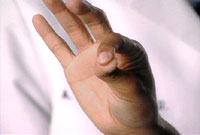Basic Causes of
Wrist Pain
Function of the Hand and
Wrist
The human hand is an
extremely complex and finely-balanced structure. There are more than
25 bones in the human hand and wrist. The wrist joint provides
flexibility and strength for the hand to perform an infinite variety
of tasks. The two major functions of the hand, shown at left, are (1)
the pinch, which uses the thumb and index finger, and (2) the
power grip, which usually involves closing the hand around an
object. The wrist joint can extend upward or flex downward, and can
move laterally from side to side (see illustrations at left).
Principle Causes of Wrist
Pain
There are two principle
reasons for wrist pain. A sudden event or an acute injury can break a
bone or tear a ligament. Less apparent, but more slowly developing
insidious causes of wrist pain are repeated patterns of activity,
which over time may cause undue strain on the wrist. What can result
is commonly referred to as Repetitive Strain Injuries, which include
(1)
Carpal Tunnel Syndrome, and (2)
DeQuervain’s Disease.
Other potential causes
of wrist pain include diabetes, thyroid disease, arthritis, and
pregnancy (which can cause severe swelling and other wrist problems).
Traumatic Arthritis
The healing process
which results from the traumatic stress of a sudden injury often
causes
arthritis. An accident occurs, and the bone or the connecting
ligaments are broken or torn. After the broken bone fragments are
realigned, even if the realignment appears to be perfect, there will
still be some distortion. Over time, the broken bones will settle,
increasing the distortion, and the surfaces of the bones will tend to
rub and wear out. The cartilage lining on the end of the bones is
especially susceptible to this “wearing out” process, and as the
tissues and linings around the bone become irritated and swell,
scarring will eventually occur. All of these relatively small changes
will cause a greater degree of stress over time on the bones and the
cartilage, and inevitably arthritis will result.
>
Radius & Ulna Fractures
>
Scaphoid Bone Fractures
>
Carpal Tunnel Syndrome
>
DeQuervain’s Disease
>
Arthritis
